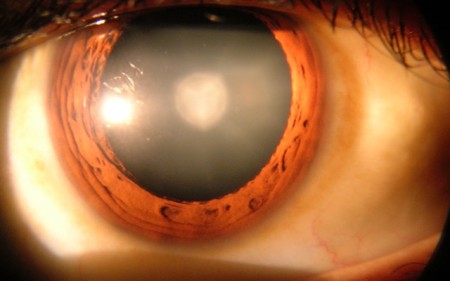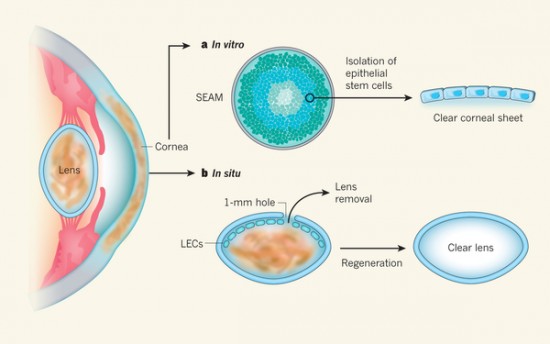March 11, 2016 – University of California-San Diego, Sun Yat-sen University and Sichuan University (the latter two in China) have pioneered treatment to repair the eye sight of babies born with cataracts. The results appear in the journal Nature this week in an article entitled, “Lens regeneration using endogenous stem cells with gain of visual function.” A trial involving 12 patients successfully stimulated native stem cells within baby’s eyes to regrow their natural lens.
Using skin cells and reverting them to become pluripotent stem cells is not what we are talking about here. These stem cells are native to the eye and are defined as endogenous. Their specific name: lens epithelial stem cells or LECs. Seen in the illustration below LECS are one kind of stem cell found in the eye. They specifically serve to regenerate natural cells throughout the life of the lens slowing down as we age which explains why cataracts typically are an age-related disease.
Today 3 in 10,000 children suffer from cataracts or cloudy lenses at birth or shortly thereafter. It is, therefore, one of the most significant contributors to childhood blindness. Treating it using conventional adult cataract replacement surgery is difficult. In a baby replacing a natural lens with an intraocular implant is not typically done until a child is age five or older. Done earlier an implant has to compensate for adult growth (an increase in size of 2 millimeters.) It doesn’t sound like much but lens replacement in children under five leads to many potential complications including inflammation, glaucoma, astigmatism, and severe myopia. Almost all post-surgical interventions lead to the children suffering from from myopia and the need for corrective external lenses.
Professor of Ophthalmology and Chief of Ophthalmic Genetics at University of California-San Diego, Kang Zhang, describes the importance of this medical first describing it as a paradigm shift for treatment of cataracts. He states, “The success of this work represents a new approach in how new human tissue or organs can be regenerated and human disease can be treated, and may have a broad impact on regenerative therapies by harnessing the regenerative power of our own body.”
Today, age-related cataracts afflict 20 million people annually. The World Health Organization attributes 51% of world blindness to this phenomenon. By age 65 more than 90% of lenses exhibit cataracts and between the ages of 75 and 85, 50% of adults suffer from some level of vision loss. More than 4 million intraocular lens operations to correct the defect are performed annually. With this new technique using a person’s endogenous stem cells to repair lenses with cataracts would mean an end to the need for transplants and their potential complications.










